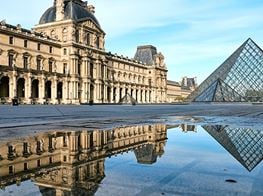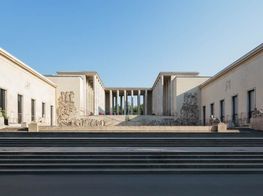A New Contemporary: 'Nouvelles Vagues' At The Palais De Tokyo
Nouvelles Vagues (29th June to 9th September 2013) is a sprawling exhibition. A collaboration between the Palais de Tokyo in Paris and the Comite professional des galleries d’art (the professional galleries committee), twenty-three projects curated by 21 international young curators from 13 different countries either working individually or within groups are presented in the Palais de Tokyo’s cavernous, modernist space (inaugurated in 1937 on the occasion of an international exhibition for technology and the arts). Meanwhile, thirty galleries in Paris have also invited young curators to stage shows within the framework of the exhibition and its aim to present contemporary art’s ‘new ecosystem’.
The result is a constellation of constellations. At the Palais de Tokyo, individual exhibitions exist side-by-side, at once in relation and independent of each other, from File Not Found (artists Randy Chan, Zaki Razak, Lee Wen, and Joel Yuen); Anthea Buys and Mikhael Subotzky’s This House, in which works by five artists (including Gordon Matta-Clark) explore the notion of structure (most literally in the site-specific construction by Serge-Alain Nitegeka); to A History of Inspiration (curated by Adnan Yildiz), The Floating Admiral (by Cartel de Kunst) and Le Club des Sous l’Eau named after the first diver’s club in the world founded by Jean Painlevé with Captain Yves Le Prieur (curated by Fanny Schulmann and Gallien Déjean). There are various other site interventions by Hicham Berrada, Nina Childress, Gonçalo Sena, and Toiletpaper magazine, not to mention a Guerilla Girls project.
On its official map, the exhibition begins with La Méthode Jacobsen, curated by Marc Bembekoff. To get here one must follow the hot pink tape (a colour once synonymous with Surrealist French fashion designer Elsa Schiaparelli) from the entrance down to level O, from where the tape traces a route across the exhibition’s three floors. Including artists Theo Turpin, Julie Bena and Feiko Beckers, La Méthode Jacobsen takes theories of neuromuscular relaxation and applies them to the exhibition format; video, photography, sculpture and installation work together to produce a hypnotic space. Somehow, it feels more like a grey rather than ‘white cube’.
The next exhibition, The Black Moon, takes this one step further. The space is treated like a film set; quite literally shaded black by the shadows produced from low-lighting. Works include Emilie Pitoiset’s sculptures that turn everyday items such as leather gloves into tightly-composed and somewhat eerie objets d’art here positioned perfectly between Ursula Mayer’s Le dejeuner en fourrure (2008), which imagines an existential discourse between Josephine Baker, Dora Maar and Meret Oppenheim, and Pierre Huyghe’s The Host and the Cloud (2010), a film composed of both staged and improvised scenes acted out in the building that used to house the Musée National des Arts et Traditions Populaires in Paris.
Curated by Sinziana Ravini, The Black Moon represents a love story between two people who have crossed paths in the art world countless times only to meet in 2013 at the Venice Biennale and then this show at the Palais. In a dialogue imagined by Ravini in an accompanying book and film, the two protagonists dance around artworks as laboriously as they dance around their mutual attraction. The conceptual implication of this interaction is clearly articulated in the curatorial statement: ‘On one hand, we have random materialism that seeks only fugitive encounters; on the other, a romantic idealism that negates the object of its desire, preferring an idea of passion that will never evolve into a true knowledge of the other.’
This complicated subject-object-subject relationship ignites Nouvelles Vagues. In Antigrazioso, works by Anne Collier, Darren Bader, Paolo Gioli, Thomas Glendenning Hamilton, Enrico Imoda, Cameron Jamie, Medardo Rosso, and Albert von Schrenk-Notzing, are perfectly curated by Luca Lo Pinto. Together, they explore the idea of transfiguration, mediumship and the illusion of photography through a combination of sculpture, sound, video and photographs placed alongside a YouTube clip of deceased rapper Tupac Shakur’s hologram performance at Coachella 2012. This grouping fits with Champs Elysées, curated by Julie Boukobza, Simon Castets and Nicola Trezzi. Here, works by artists including Haim Stainbach, Danae Anesiadou and Hans Peter Feldman invoke our mortal reverence towards the age-old cycle of life and death through object and performative ritual.
Taking advantage of the Palais de Tokyo’s sheer size, the exhibition also has its fair share of large-scale installations, including Concert Hall, a group installation curated by co-founder of the Flux Factory in New York, Jean Barberis in collaboration with Georgia Muenster. A digital cave-cum-music box constructed by the collective Rabid Hands and Sunita Prasad, the computerized installation is responsive to the public’s impulses and a MIDI system activates musical compositions by Julien Gasc, Nick Yulman and Ranjit Bhatnagar (played on automated glockenspiels) and interactive light works by maya.rouvelle and Frederic Durieu. Installed nearby at Le Point Perché (the headquarters of the institution’s events program) is Jacques Comité [Giacometti]. Conceived by artist Michael Riedel and produced in collaboration with Absolut Art Bureau, it is set to host events throughout the year. Essentially a bare room divided up into a bar with seating made from plinths and wall texts/dividers used in an exhibition of works by Giacometti at the Hamburger Kunsthalle in 2013, the space is white but covered with black ‘O’s (which were gleaned from Riedel’s recording of the disassembling of the Giacometti exhibition) and words taken from Giacometti’s exhibition text. Here, the exhibition apparatus is foregrounded rather than the artworks themselves.
Post-2008, art has been adapting to what feels at times like a global, economic restructuring. But when thinking about the ‘rhizomatic’ field of contemporary art, this ‘shakiness’ also allows for malleability since it necessitates the development of new networks and relationships.
On Jacques Comité, Riedel notes that his interest in the ‘O’ was that a circle marked both a boundary and a space – an inside and outside simultaneously. This notion of inter-changeability was similarly invoked in Henrique Oliveira’s impressive Baitogogo, curated by Marc Bembekoff, in which the artist has turned the columns of the Palais de Tokyo into the trunks and branches of trees breaking through concrete as if with organic necessity to form a Gordian knot - the institutional building, and by implication the institution, as rhizome. Outward looking, connective, and expansive.
Yet, this idea of networked culture also recalls an essay published in the Palais De Tokyo Magazine produced especially for the exhibition. Lee Wen of Black Ninja Collective describes the individual, as it exists within the current context of global capitalism: ‘The process of differentiation and separation between us makes functioning within previously shared notions of common ground uncertain and shaky’. It’s true. Post-2008, art has been adapting to what feels at times like a global, economic restructuring. But when thinking about the ‘rhizomatic’ field of contemporary art, this ‘shakiness’ also allows for malleability since it necessitates the development of new networks and relationships.
Extending the exhibition out into Paris’s galleries underscores the fluid approach to art’s systems and structures proposed in Nouvelles Vagues. Walking from the city’s 3rd Quarter to see Martin Barré and R.H. Quaytman’s excellent Arrhythmia (A Tale of Many Squares) curated by Paul Galvez at Galerie Natalie Obadia, to the Pont de Neuf, where artist Laurent Grasso has curated a stellar collection of works by Man Ray, Francis Picabia, Rene Iche, Heinrich Hoffman and Hans Bellmer at Galerie 1900-2000, it is the move from Palais de Tokyo’s modern institutional framework to the postmodern network of galleries operating in a historical urban hub that makes this exhibition so engaging. Everything has been activated: city, institution, gallery, curator, artist, object, and viewer. — [O]












































































































































































